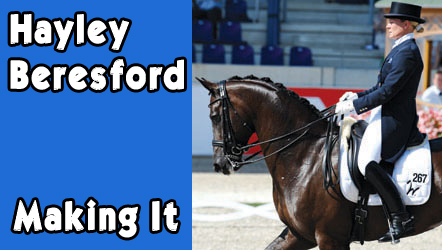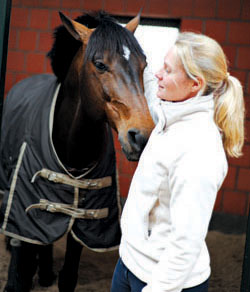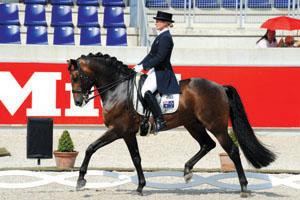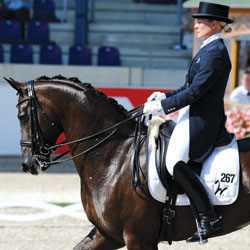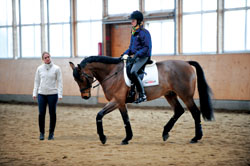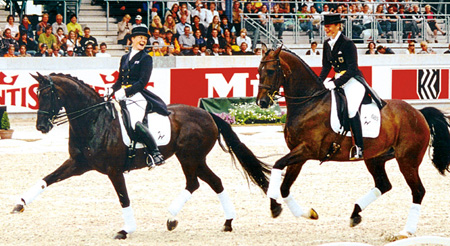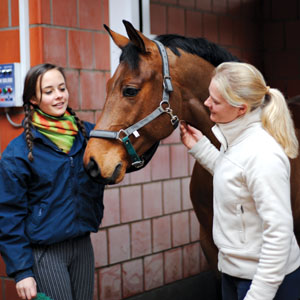It’s a huge understatement to say it has been a big twelve months for Australian dressage rider, Hayley Beresford. Not only has she achieved the almost unprecedented feat of taking the first horse she ever trained to Grand Prix level to the Olympic Games, but she also married Kia Bullock, AND took the mare Rhapsodie Queen into 5th place at Germany’s top show for young FEI horses, the Nürnberger Burgpokal. Wow!
But when we caught up with Hayley at Isabell Werth’s dressage training complex in Rheinberg, the bubbly blonde from Western Australia looked very relaxed about the whole process. Although she did confess that the Olympic Games were not really on the agenda when she started work with the handsome bay Lusitano that took her to Hong Kong.
“When I got Relampago, he had done some Prix St Georges tests with a Brazilian rider. We hadn’t envisaged Hong Kong from the beginning, not at all, it just went that way. It was the end of 2006 when I started with him. I did the small tour during the year, just working towards the Grand Prix. I think Isabell was always secretly thinking that Hong Kong was a little bit a possibility. She helped me. Together we worked with the horse. We had to build the horse up to learn every movement of the Grand Prix and I had to learn every movement of the Grand Prix, and it all came together at the right time to make it to Hong Kong. He is my first Grand Prix horse – and that is a credit to his temperament. He has been able to be like a School Master while only being a young Grand Prix horse himself. The next horses have been much easier to bring to the Grand Prix exercises than I found it with him, but that wasn’t through any fault of his.”
“We made our first Grand Prix in November at the end of 2006 in a small CDN, and step by step, we did more and more. He was campaigned strongly because it was necessary for the selection trials, and also necessary for me to come to Grand Prix, because you can’t do it without experience. There were a few Grand Prix, 61, 62, 61, it took a few competitions to break through that. We were ready for the show at Hagen when the Australians arrived on the pre-Games campaign. I remember being quite disappointed in Hagen because he had been going much better and I made a lot of mistakes, but the other Australians made more, so I thought I’ve still got a chance. Then we were ready for Wiesbaden…”
You had more or less given up on going to Hong Kong when you were left out of the selector’s squad for Wiesbaden – you started talking Lexington?
“We were talking Lexington from the start, we weren’t ever talking Hong Kong. I think it was a seed in both our minds from the beginning… could be… but there was no pressure to do it. No pressure from the owner, Mr Fischer, no pressure from Isabell… it was just maybe, could we, we’ll try. I wanted to experience the pressure of the selection trials to see I could go through that. When I went to Wiesbaden, I was just there to go through the process. Then when he was second in Wiesbaden, it was like ‘My God!’ Then I think I had my most nervous couple of weeks, between Wiesbaden and Lingen, but everything worked together… yeah.”
How nervous were you when you rode into the stadium in Hong Kong?
“By the time the test came, I was cool, but when we first came to Hong Kong, Sophie (my groom) and I walked into the arena… it was really hot and there was nothing set up at this point. I stood in the middle – Oh My God… what am I doing here? But there was so much time to prepare for everything. I remember coming into the Grand Prix and I just aimed for safe and careful. The day before I was really nervous, this could go wrong, that could go wrong, but by the time of the test, we were really ready. We were both a little bit inside ourselves. He came in and instead of being – he’s a bit like a Tarzan, I’m so good – instead of coming in like that he was a bit quiet. We have a nice partnership, he’s always looking for me, and in that environment I just didn’t want to scare him.”
“The experience was good because when he came out for the Special he was proud and happy to be there. Then it was fun!”
It must have been fun in the Kür at Neumünster, to score 74%?
“It was unbelievable, unbelievable… he has just come so much more mature in his body, he’s strong and he’s fit, and he is playing with the Grand Prix now. Coming to the Grand Prix, you could tell he was a baby Grand Prix horse, and I was not established either. The difference between Hong Kong and now is huge, and I can’t wait to see what he is like in another year… he’s just playing now.”
Suddenly he is immensely popular with the Lusitano breeders?
“I don’t know if it is a sudden thing. He has been very popular from the beginning, but he has a fan club and I think every day I receive emails from Portugal, Brazil, Argentina, France… wanting to know about him. He is a great example of the breed.”
“I’m not sure he is convinced he wants to be the super stud sire, but he does the job and he is very polite and nice.”
It hasn’t made him difficult to ride?
“No, he’s very sensitive but he’s not complicated with being a stallion. He can be stabled next to mares, I can ride next to a mare, and he is never stallion-y. He’s so nice to ride, he’s like a bean bag to sit on, he is so comfortable, especially in the trot, he can really swing.”
And your starry young horse – Rhapsodie Queen?
“She came to me in 2007 after Balve. I was riding Relampago in the small tour there, and some friends of Isabell’s had seen me riding him, and thought it could work with Rhapsodie Queen. This is a really good horse. I don’t think any of us realised the Grand Prix potential at the beginning, but you don’t know with a horse until you start to go Grand Prix. At the beginning, for sure she was going to be a beautiful Small Tour horse, but the mechanic was very passagey, and the piaffe wasn’t there…. Then, once we spent time with the piaffe, that’s a big toy for her, she loves it, she is always playing with it.”
“She’s nine now, she was coming eight when I started riding her. She had competed at the Bundeschampionate, and just done young horse classes – sometimes with success, and sometimes with not such success. She is quite hot and very sensitive as well, but easy to ride harmoniously. Her little quirk is that she is trying so hard all the time, she tries to do ten things at once to please you – you have to sort out what you want, and make that work. She loves to show-off, she loves the competition. You canter her up the centre line and its POW! She’s special.”
“I’m aiming to take her out Grand Prix soon. She is doing all the Grand Prix work now. This year I will aim her for the Medium Cup, for the young Grand Prix horses. It is not necessary for her to go Grand Prix as quickly as Relampago did, and she is much more sensitive, so I want to her to build within the Grand Prix in her own way, without too much pressure.”
With a horse like her, is it scary? There must be a lot of people with large cheque books trying to buy her?
“Yes. I am always nervous. When you have a good horse, of course there are going to be people who want to ride it. I’m a professional rider, I don’t own the horses – you can only hope that the owners are happy with the job you are doing, and the success of the stable. She is owned by family Katzorke – really lovely people and we have a very good relationship.”
And Mr Fischer, the stallion’s owner, seems a lovely guy?
“Mr Fischer is the coolest dude in the world. He is really easy and happy. To go to the Olympics was a dream for him, with the horse he bred and owned. But he never put direct pressure on me. He realised that it was my first Grand Prix experience. It was a real team effort. Without a good owner and a good trainer, and a good team behind you, a rider is nothing. It was really a team.”
What happens next in your riding career?
“Well my dreams are really big. I’ve been in Germany three years now. Australia is always home, but you work so hard to come onto the international tour, that you don’t want to come off it. I quite liked being in the top six at Neumünster at the weekend, so I want to keep building up on that. I think both Relampago and Queenie have a lot of time ahead of them. I have a few young horses to come up behind them. I’m part of the team here with Isabell – I’m not the only rider, I share the goal that the good riders and the good horses are coming from this stable…”
You were saying you and your husband are looking for a property in Victoria?
“Yeah, we would like something to call home. At the moment we are thinking a little block, a home point in Victoria, it doesn’t mean we’ll be going back there quickly, but we will. I’m very Australian.”
We were also lucky that day to meet up with Hayley’s mentor, Isabell Werth and get her impressions of her Aussie protégé:
When you first suggested to Hayley that she come to Germany, you were teaching in Perth?
“It was a clinic in Perth in 2005. Hayley was one member of the clinic, and of course she was the most talented rider in the clinic. She was looking for a stable as a working student. She asked maybe I can help her find a stable – I said ‘send me an email’ whatever. When she sent the email it was just at a time when it was okay for her to come here to my stable. I needed someone – and that was the beginning of the story. At first she was here for about two months, then she came back, and I said, if you want, you can stay here. Two or three times she left Germany and came back and in the end we decided, that she stays here and to be honest, it was really lucky because my bereiter became sick and injured and so it was a good situation for Hayley to get not just young horses, she could start with some more experienced horses as well.”
“Of course Relampago was far away from Grand Prix, he was on M level, but it was a good start to get talented and interesting horses.”
When Hayley started riding Relampago did you think, this girl and this horse might go to the Beijing Games?
“Not really from the start but of course, I talked to the owner, and after three or four months, she started with the Grand Prix at the end of 2007, and I didn’t promise him, but I said, maybe there is a little chance that if everything goes perfectly, there is a little chance to qualify for the Australian Team. But I was careful with this prediction, just that there was a chance and we would try. Then step by step, it came closer and closer.”
“If I look at the last two shows of the season – okay at Amsterdam, she had two mistakes in the Grand Prix which were very expensive because at that stage she was close to 66/67%. In the beginning, the big goal was 64%, and now we are disappointed when we have 65%. Sometimes I have to keep her on the ground so that she is not expecting too much because I know after twenty years that it goes down as well as up, and you have to come through both situations. At the moment they are all happy and positive and everything is on a super way, but we have to be prepared that another time will come, and she has to go through that in the same way. Right now, Hayley is on a really super way and you can see the experience of the last two years – it begins in the warm-up and finishes in the competition. She becomes more and more safe as she goes through the competition. I was really happy how she went at Neumünster. The Grand Prix and the Freestyle were the best tests she has ever had, and I was really proud of her.”
Is it hard for you, when you are riding at a big show and Hayley is riding so you are half a trainer, half a competitor?
“It depends. It is not hard because she is uncomplicated and she can work by herself really well. She is part of my whole team, and if I have no time, there is no problem for Wolfram Wittig, or Holger Schmezer or Johnny Hilberath to work with her. In Hong Kong, I had to prepare for my competition on the second day, then Johnny was training her. It is an easy community and it works very well. I feel no pressure, I’m not nervous that I have to take care of her – it works really easy.”
There are lots of young girls who start out to become dressage riders, and not many succeed – why do you think Hayley has been successful?
“Of course you need the talent and you need the mind. These are two points where she is really strong – she is always thinking what she has to do to become better. You can see from one day to another, when we work on some special things, that she has been thinking about it. She’s a rider with a good overview. In a competition she doesn’t become frantic or nervous. Some riders are good in the warming up arena, but they are not good enough in the competition because they lose their self-confidence and they stop riding – they stop breathing! With Hayley, whatever happens in the warm up, you can be sure in the competition she will try her best and get to the end whatever happens on the way. That is one part of her strength – and of course the talent to improve a horse. If you compare the first competitions to today, there is a huge difference in just one and a half years, and that is really outstanding.”
You just have to agree – in three short years, Hayley has achieved so much in Europe, and you get the feeling, the best is soon to come…



